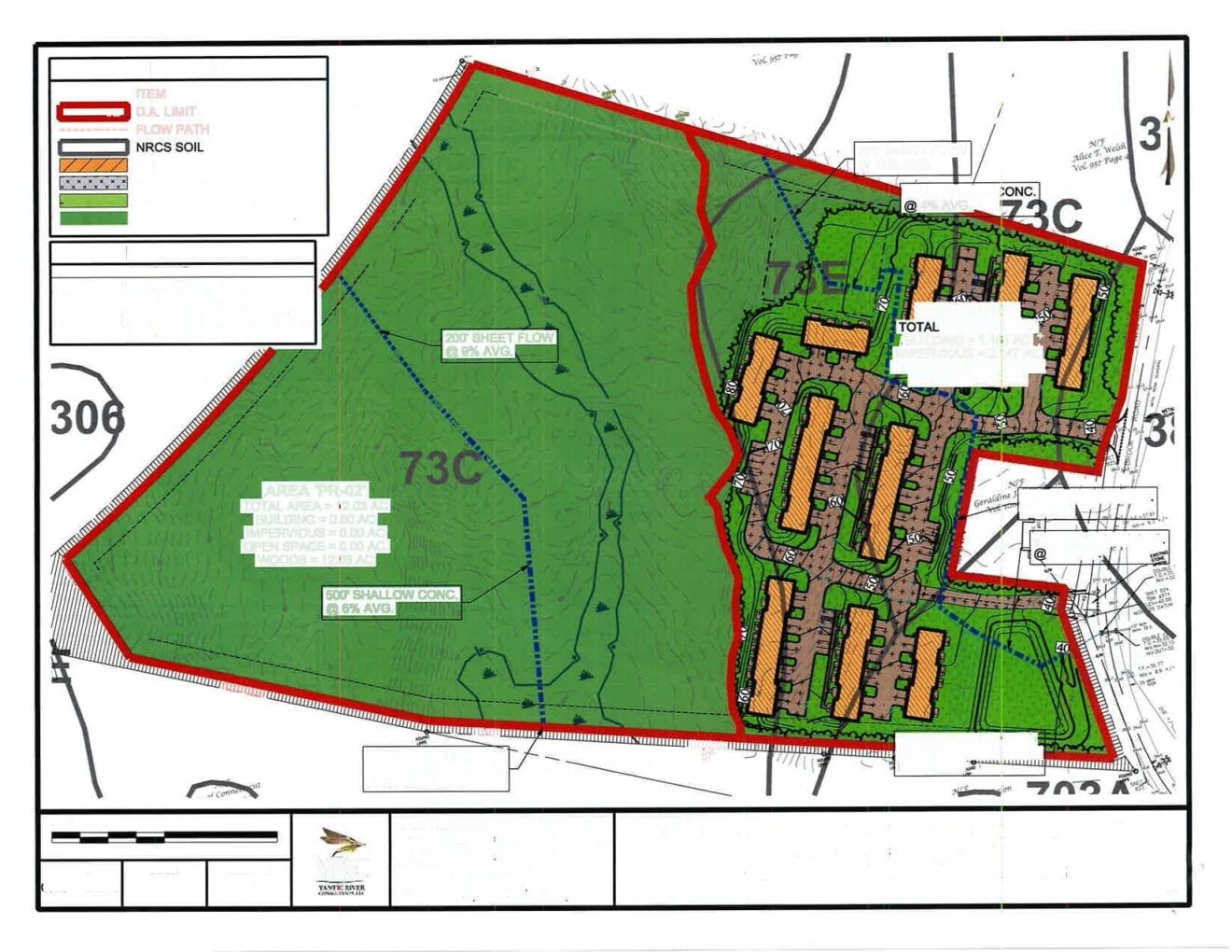EAST LYME — In its referral to the town’s Zoning Commission, the East Lyme Planning Commission unanimously agreed on Tuesday night that a proposal for “Brookside Apartments,” an 80-unit development on North Bride Brook Road, submitted under the state’s 8-30g affordable housing statute, was inconsistent with the town’s 2009 Plan of Conservation and Development (POCD), with a few exceptions.
The Planning Commission found that the site lacks public transportation and is not close to a village center, as recommended by the POCD for affordable housing projects.
The commission did, however, find that the proposal met provisions in the POCD for access to the thoroughfares of Route 156 and the I-95 Rocky Neck corridor and for adding affordable housing to East Lyme.
Developer Jason Pazzaglia, who owns the Pazz & Construction LLC of East Lyme, originally proposed 13 buildings containing 108 units under the 8-30g statute on the 20.24-acre site at 90 North Bride Brook Road. The 108-unit project was unanimously rejected without prejudice by the Inland Wetlands Commission on May 18, stipulating that several of the planned buildings needed to be relocated or eliminated because of potential runoff into the nearby watercourse on the site, and that no hydrology report had been submitted with the application.
The project will use municipal water and sewer. The East Lyme Water and Sewer Commission granted the development 35,400 gallons per day of sewer capacity on August 27, 2019.
Pazzaglia purchased the property in 2017 for $450,000.
As currently planned, the new 80-unit proposal will contain 24 affordable units and 56 market rate units. The complex will contain 20 three-bedroom units, 20 two-bedroom units with an expanded footprint and 40 standard two-bedroom units. Thirty percent of the total units will be designated as affordable, including six three-bedroom units, six two-bedroom units with an expanded footprint, and 12 standard two-bedroom units.
According to the project affordability plan, the affordable units will be restricted for 40 years based on the initial occupancy of each unit. No fewer than 15 percent of the affordable units will be rented to individuals or families whose income is less than or equal to 60 percent of the area or statewide income, whichever is less.
The remainder of the affordable units will be rented to families whose income is less than or equal to 80 percent of the mean East Lyme or statewide income, whichever is less.
Based on an area median income (AMI) of $94,500, calculated from 2019 data, the 60 percent median income rent for a three-bedroom apartment in the complex is estimated at $1,117. A two-bedroom apartment will rent for about $1025. For an individual or family earning between 60 and 80 percent of AMI, the rent for a three-bedroom apartment is estimated at $1,590 and for a two-bedroom apartment $1,451.
Gary Goeschel II, planning director and wetlands enforcement officer for East Lyme, said the development required a car to access jobs and shopping, which was inconsistent with the recommendations of the POCD.
“There is no public bus route directly and it’s not located in either of the village centers — those are two big shortcomings that our POCD hammers on,” he said.
Kirk Scott, chair of the commission, said he was concerned about the lack of public transportation and the distance to any town center.
Michelle Williams, a member of the commission, said the project was “technically affordable,” but she had reservations and questions about 8-30g.
“We’re being put in a position where in order to get 24 units of affordable housing, we also have to accept [56] market rate units of high density housing in a place that’s not zoned for high density housing,” she said. “And that’s not the fault of the developer in this situation and there’s nothing that we can really do with the state regulations — this is completely legit.”
Williams said state statute is formulated in a way that the numbers will never bring the town closer to the state’s 10 percent threshold for affordable housing.
“We’ve come into this situation a number of times … where we are not able to satisfy our affordable housing needs or desires to bring in actual volumes of affordable housing because we’re sticking them into these other large market rate developments,” she said. “We’re just adding more market rate while we add more affordable, so we’re just chasing that percentage and in the meantime not really getting the kinds of affordable housing that are useful to people in areas that are most appropriate, not just the buses, but for people’s lives.”
The Zoning Commission will hear the proposal on Nov. 5.
According to state statute 8-3a, “a proposal disapproved by the planning commission may be adopted by the Zoning Commission by a vote of not less than two-thirds of all the members of the Zoning Commission.”
However, Goeschel pointed out, the Zoning Commission must have a two-thirds vote to approve the proposal, regardless of the referral from the Planning Commission.

